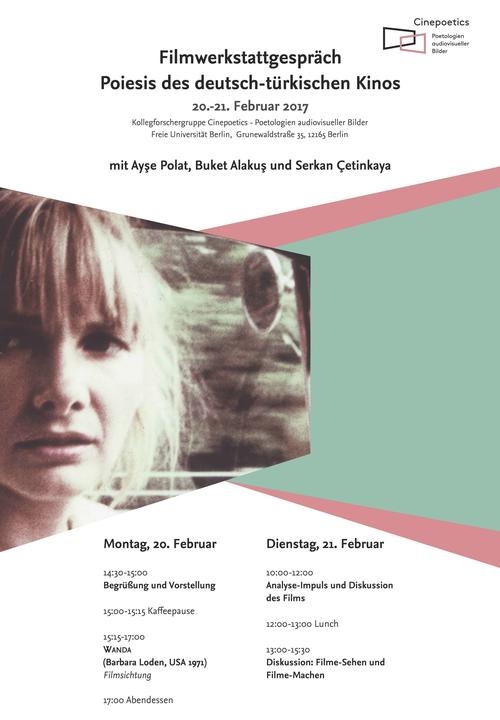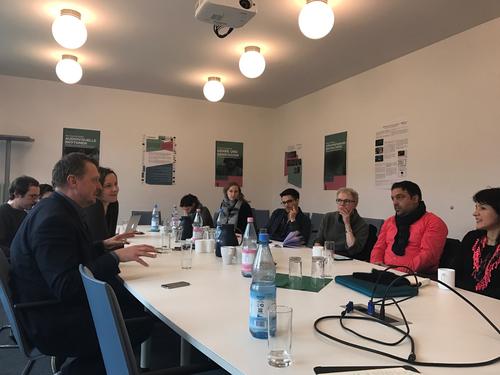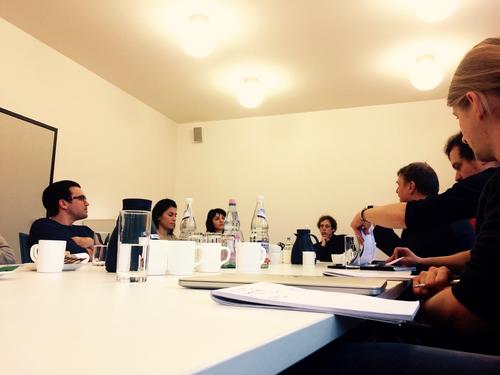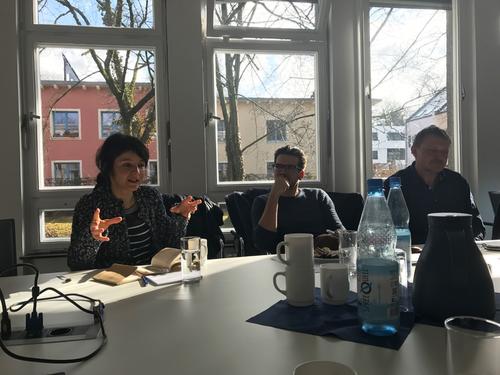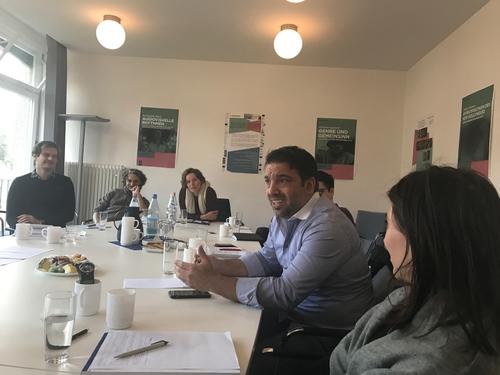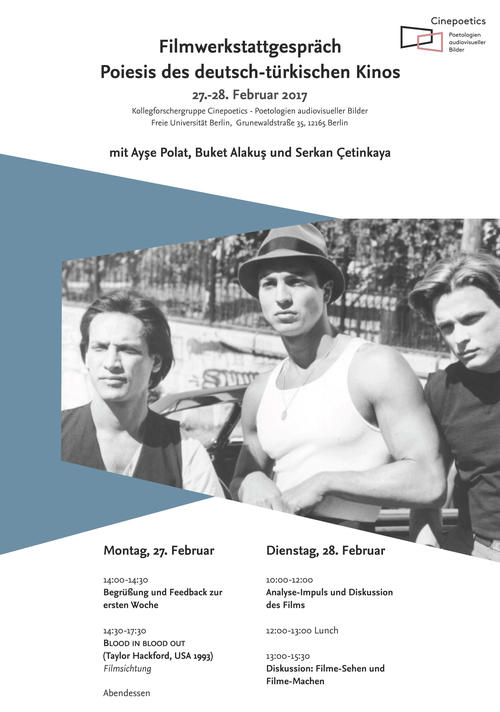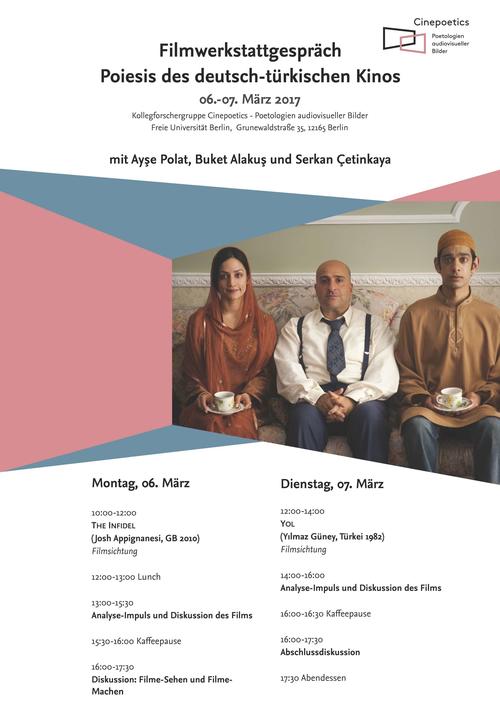The Poiesis of German-Turkish Cinema
21./22./27./28.02., 05./06.03.2017 | Workshop by the Cinepoetics group with Buket Alakuş, Serkan Çetinkaya and Ayşe Polat.
In February and March, 2017, Cinepoetics hosted the first so-called "focus group" of the center's associated research project, "Migrant Melodramas and Culture Clash Comedies" (CRC 1171 "Affective Societies: Dynamics of Social Coexistence in Mobile Worlds"). In three analytical talks with Cinepoetics members and filmmakers Buket Alakuş, Serkan Çetinkaya, and Ayşe Polat, whose work is often subsumed under the label "German-Turkish Cinema," said label was critically discussed over the course of three weeks.
The project investigates the productivity and problematic implications of the term "German-Turkish Cinema," arguing that similarities between the films in question have to be discovered in the ways in which they position themselves in an audiovisual entertainment culture, and not on the level of representation. Thus, the films should be described as testimonies of film viewing. The project members therefore analyze how cinematic images absorb, appropriate, re-evaluate and transform other images, that is, how the films of "German-Turkish Cinema" communicate with each other.
Filmmakers Ayşe Polat and Serkan Cetinkaya in conversation with Hermann Kappelhoff and members of Cinepoetics
The project investigates the productivity and problematic implications of the term "German-Turkish Cinema," arguing that similarities between the films in question have to be discovered in the ways in which they position themselves in an audiovisual entertainment culture, and not on the level of representation. Thus, the films should be described as testimonies of film viewing. The project members therefore analyze how cinematic images absorb, appropriate, re-evaluate and transform other images, that is, how the films of "German-Turkish Cinema" communicate with each other.
For the project's focus groups, the film-analytical discussion serves as a central mode of working. Based on key film screenings, the participants talk about the poetic logic of each film, about the ways it relates space and time, lighting, sound, and montage to one another—about the ways it organizes a world that makes itself seen and heard in audiovisual images. Since the experience of concrete spectators is itself part of these images, filmmakers can be conceived as "privileged" spectators who directly connect the perception of images with the production and emergence thereof.
In this spirit, the aim of each group meeting was to further affirm and define the following hypothesis: Filmmaking flows from the act of film viewing. How do these two activities correlate? What audiovisual discourses do we situate ourselves in when perceiving and producing images? In order to further inquire these connections, we watched films that our guest filmmakers chose. Rather than proposing examples of "German-Turkish Cinema," they presented films that had been influential for their respective work, without alluding to direct links in the form of filmic quotes.
The first film, selected by Ayşe Polat, was Wanda (Barbara Loden, USA 1970). A first analytical impulse focused on the film's central conflict between divergent temporalities. Wanda's character embodies a principle of "not keeping up," one of balking at smoothly running procedures. This conflict, however, is not primarily grounded in the (rudimentary) psychology of the character itself, but mainly in the process of "bringing this character into the world" in the first place. In doing so, the film consequently refuses to fall into familiar generic patterns in which the place of the woman would seem predetermined. Instead, Loden's work resembles a search for the possibility to reveal a character, a face, in its own right.
The relationship between generic form and a particular determination of position turned out to be an important theme for the following group meetings. The second film, Blood In, Blood Out (Taylor Hackford, USA 1993), was selected by Serkan Çetinkaya. While Wanda thematizes the status of an individual character, this film centers on conflicts between highly symbolical codes and orders—strictly differentiated ways of relating to the world—that operate on the level of collective communication. These orders are emphatically related to urban space and its diverse partitions that are either created by police action or as results of numerous fights between rivaling street gangs. The implementation, modulation, and transformation of this organizing principle that wraps itself around the space of the city like a net of visual markers (tattoos, murals, color arrangements, street signs) forms the film's affective dramaturgy which includes the audience in the emergence of a feeling for the world. In contrast to Wanda the film makes use of forms of popular culture (music videos, comics, Godfather folklore) to relate this feeling to a specific historical situation, the L.A. riots of the early 1990s.
For the third week, Buket Alakuş chose a comedy, The Infidel (Josh Appignanesi, GB 2010), and broadened the spectrum of discussed films once more. While Wanda is held in high esteem for what concerns its status as a (long-forgotten) feminist film, and Blood In, Blood Out is considered a cult film by migrant communities worldwide, The Infidel is a recent example of comedies that—on the level of plot representation—are concerned with conflicts that can arise within migrant communities. In a certain sense, this film takes an intermediate position between the other two in that it asks how culturally circulating racial stereotypes and clichés become visible through specific characters. The film stages this constellation as a balancing act—the body of the protagonist is caught in a web of judging looks which, in turn, can be manipulated through smart fabulation. Here, the smooth transition between "authentic" expression and the simple reproduction of clichés is highlighted in ever new variations. According to the film, identity is not to be understood in a substantial sense, but only in connection to (generically modulated) performance situations.
Finally, we watched Yol (Yilmaz Güney, TUR 1982), a film that not only made Turkish Cinema visible for an international audience, but one with great influence on those filmmakers who have since been relating to this cinema as a context of shared experience. This added a historical dimension to the group's previous discussions. At the same time, the film is also concerned with the perspective of individual world relations within the context of hierarchical social orders. It subjects particular narrative episodes to a forcibly implemented regime of temporality. This once again demonstrates that cinematic images have the potential to facilitate the experience of a community's "distribution of the sensible" (Jacques Rancière) as a mechanism of political control—a mechanism that extends to the most intimate relationships.
